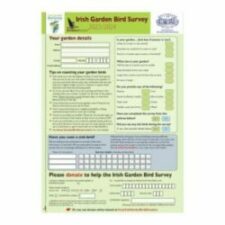
Irish Garden Bird Survey 2023/24 – Survey Form
The survey form for taking part in the Irish Garden Bird Survey for winter 2023/24. The survey starts in the week beginning Monday November 27th 2023, but don’t worry if…
The Irish Garden Bird Survey is open to everyone and it couldn’t be easier to take part! It’s a great way for you and everyone in your house to really get to know your garden birds and is now a firm winter tradition in many households across the country. BirdWatch Ireland have been running this survey for 30 years and we’re delighted to have the Ballymaloe group as the survey sponsors. By taking part you’re helping provide us with really important information on how our garden and countryside bird populations are faring during the harsh winter months each year.
The survey is open to everyone, so make this winter the one you get involved! See below some guidance on how to carry out the survey, and some of the most frequently asked questions about taking part.
The Irish Garden Bird Survey runs from the first week of December to the last week of February every winter, which amounts to 13 weeks. For winter 2021, the survey begins in the week of Monday 29th November.
It’s not necessary to carry out the survey in every single week, as people are often away from home over Christmas etc., but if you can complete at least 10 of the 13 weeks then you’ll still be providing us with a high level of bird data.
The survey is focusing on garden birds – so that’s any species that uses your garden in a given week. Some birds will be on feeders, others on the ground, perched in trees and hedges, and all of these should be recorded. Birds of prey should be recorded too, if they’re hunting over your garden (even if they don’t land).
Don’t record other species that are genuinely just flying over your garden though, with no intention of using it – for example if a flock of Lapwing or Whooper Swans fly over the house, or land in the field next door – don’t record these for the survey.
If there’s a species that you’re having trouble identifying, it’s valuable to have a good bird book to hand but don’t be afraid to get in touch with us and we’ll try and help you identify it!
We want to know the highest number of each species you see at any one time each week.
So, if you see two Goldfinches in the morning and three in the evening, then the highest number you’ve seen at any one time is three – so that’s your count ‘to beat’ for the rest of the week. Three is the number for that week, unless you see a higher number at any one time later in the week. Start fresh the next week then!
Similarly, if you see one Robin today and one Robin tomorrow – the highest number at any one time is still just one.
Never sum up birds seen at different times of the day, or on different days.
A good rule of thumb is that you’re unlikely to ever see more than two or three Robins at any one time (it’ll usually be one or two), so if you find yourself writing a much higher number down any week then double-check that you’re recording things correctly!
Yes it definitely is!
The survey benefits from having a wide variety of garden types and locations included each year. So, whether your garden is big or very small, whether you’re in the middle of a city or a completely isolated part of the countryside, or even whether you feed your birds or not, we’d love for you to take part in the Irish Garden Bird Survey.
That’s completely up to you. A lot of people will keep an eye on the birds in their garden for a few minutes on mornings or evenings during the week, before or after work or school, and then more time over the weekend. That’s absolutely perfect.
There’s no need to dedicate hours to staring at your feeders (though you certainly can if you want!), but casual glances out the window when you get the chance during the week and on the weekend should give you a good feel for the species and numbers using your garden each week.
A good bird book, particularly one that focuses on Irish species, is always recommended and an investment that will last you a lifetime. If you visit the ‘List of Ireland’s Birds’ section of our website, there are various search options to help you narrow down the options, but if you still have difficulty please don’t hesitate to email us at info@birdwatchireland.ie and we’ll do our best to help you identify it (if you can get a photo that always helps!).
The form to record your results in is published in the winter issue of our Wings magazine, and available to download by clicking here.
You can submit your results via our online data system (click here), by emailing your count form to gardenbirds@birdwatchireland.ie or by posting your count form to us at the address below:
BirdWatch Ireland,
Unit 20 Block D,
Bullford Business Campus,
Kilcoole, Co. Wicklow
Results from the Irish Garden Bird Survey are published in the winter edition of our Wings membership magazine each year, which usually reaches members in early November.
Click here to read the results from the 2017/18 Irish Garden Bird Survey.

The survey form for taking part in the Irish Garden Bird Survey for winter 2023/24. The survey starts in the week beginning Monday November 27th 2023, but don’t worry if…
Ireland’s biggest bird survey is open to everyone and a great way to learn about the birds in your garden. Taking part is easy and provides us with really important data on how our garden bird populations are doing from year to year.